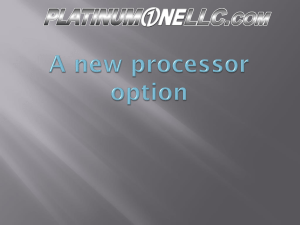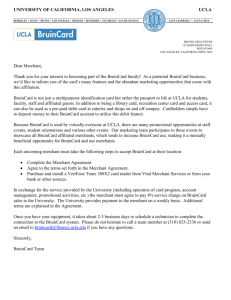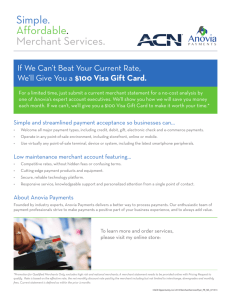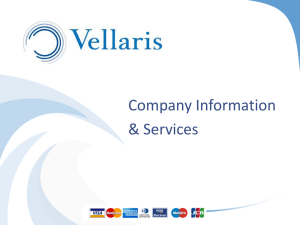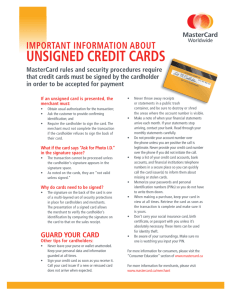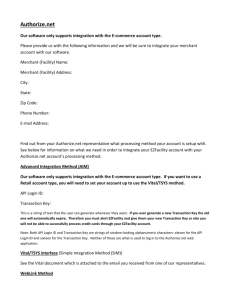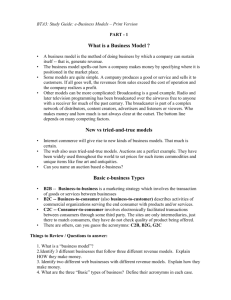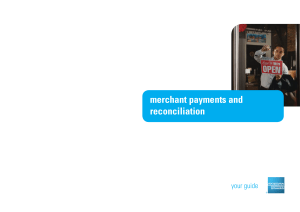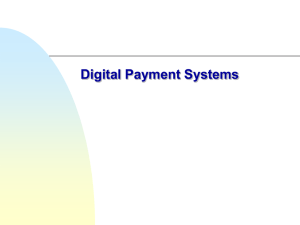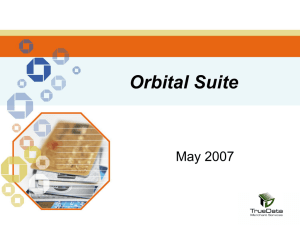E-Commerce Payment Systems
advertisement
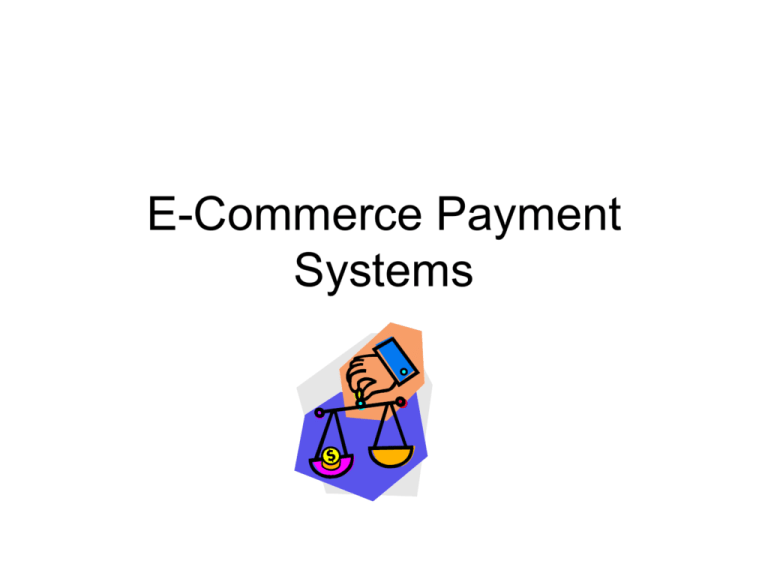
E-Commerce Payment Systems . Topics • • • • • • The E-Commerce environment Traditional payment systems Online payment with credit cards Online payment with SET Other online payment systems B2C and B2B 2 Internet Fraud Complaints Reported to the IFCC (2004) 3 Online Credit Card Purchases are Risky for the Merchant • Many security procedures that credit card companies rely on are not applicable in online environment (CNP). • Merchant pays when goods are not delivered, order is disputed or in cases of credit card fraud. • Percentage of Internet transactions charged back to online merchants much higher than for traditional retailers (3-10% compared to ½-1%) • To protect selves, merchants can: Refuse to process overseas purchases Insist that credit card and shipping address match Require users to input 3-digit security code printed on back of card 4 Customer and Merchant Views 5 E-Commerce Transaction 6 Points of Vulnerability 7 E-Commerce Availability • Digital Divide: Some groups don’t have same access to computers and Internet that others do • Digital “have nots” include: – – – – – – Households with incomes below $35,000 Those without college educations People living in rural areas African-Americans and Hispanics Seniors over 65 Disabled • Most recent Department of Commerce study -most of above groups gaining access to computers and Internet due to falling computer prices and free or low cost ISPs 8 Traditional Payment Systems • • • • • Cash Checking Transfer Credit Card Stored Value Accumulating Balance 9 Cash • Legal tender defined by a national authority to represent value • Most common form of payment in terms of number of transactions • Instantly convertible into other forms of value without intermediation of any kind • Portable, requires no authentication, and provides instant purchasing power • “Free” (no transaction fee), anonymous, low cognitive demands • Limitations: easily stolen, limited to smaller transaction, does not provide any float 10 Checking Transfer • Funds transferred directly via a signed draft or check from a consumer’s checking account to a merchant or other individual • Most common form of payment in terms of amount spend • Can be used for both small and large transactions • Some float • Not anonymous, require third-party intervention (banks) • Introduce security risks for merchants (forgeries, stopped payments), so authentication typically required 11 Credit Card • Represents an account that extends credit to consumers, permitting consumers to purchase items while deferring payment, and allows consumers to make payments to multiple vendors at one time • Credit card associations – Nonprofit associations (Visa, MasterCard) set standards for issuing banks • Issuing banks – Issue cards and process transactions • Processing centers (clearinghouses) – Handle verification of accounts and balances 12 Stored Value Accounts • Accounts created by depositing funds into an account and from which funds are paid out or withdrawn as needed • Examples: Debit cards, gift certificates, prepaid cards, smart cards • Debit cards: Immediately debit a checking or other demand-deposit account • Online Peer-to-peer payment systems such as PayPal 13 Accumulating Value • Accounts that accumulate expenditures and to which consumers make periodic payments • Examples: utility, phone, American Express accounts 14 Most Common by Number of Transactions 15 Most Common by Dollar Amount 16 Payment Systems Characteristics 17 Online Payment Systems • Credit cards are dominant form of online payment, accounting for around 80% of online payments in 2002 • New forms of electronic payment include: Digital cash Online stored value systems Digital accumulating balance payment systems Digital credit accounts Digital checking 18 Actual and Preferred 19 Online Credit Card Use • Processed in much the same way that instore purchases are • Major difference is that online merchants do not see or take impression of card, and no signature is available (Cardholder Not Present transactions) • Participants include consumer, merchant, clearinghouse, merchant bank (acquiring bank) and consumer’s card issuing bank 20 Online Credit Card Use 21 Problems with Online CC Use • Security – Neither merchant nor consumer are authenticated. Merchant gets consumers credit card number for possible later misuse. • Cost – for merchants, around 3.5% of purchase price plus transaction fee of 20-30 cents per transaction • Social equity – many people do not have access to credit cards (young adults, plus almost 100 million other adult Americans who cannot afford cards or are considered poor risk) 22 SET (Secure Electronic Transaction) Protocol • Developed to address deficiencies in online credit card use. Open standard developed by MasterCard and Visa. • Authenticates cardholder and merchant identity through use of digital certificates. • Transaction process similar to standard online credit card transaction, with identity verification. • Thus far, has not caught on much, due to costs involved in integrating SET into existing systems, and lack of interest among consumers 23 SET at Work • SET uses SSL and PKI. Customer must have a SET enabled browser and merchant needs SET enabled server. • Consumer’s credit card issuing bank issues a digital certificate (electronic wallet) with consumer’s public key and bank’s public key (signed with bank’s private key). • Merchants get a similar digital certificate from bank. 24 SET at Work: Step 1 • Customer places online order: C’s browser receives M’s certificate and validates it. • C’s browser sends the order message which is encrypted with M’s public key and contains: – order information for Merchant, – C’s digital certificate and – payment (credit card) info which is encrypted with the bank’s public key so M cannot read it. The payment info contains a transaction ID (originally from M) so that it can only be used with this particular order (no replay attack). 25 SET: Step 2 and 3 • The Merchant verifies C’s digital certificate. • The Merchant sends to the bank – Order information – Payment info from C which M cannot read – M’s certificate • Bank verifies message, handles money transfer and sends signed authorization to merchant who can then process the order. 26 SET Transactions 27 Other Online Payment Systems Digital Wallets 28 Digital Wallets • Concept of digital wallet relevant to many of the new digital payment systems. • Seeks to emulate the functionality of traditional wallet. • Most important functions: Authenticate consumer through use of digital certificates or other encryption methods Store and transfer value Secure payment process from consumer to merchant • Two major categories: Client-based digital wallets – Gator.com, MasterCard Wallet Server-based digital wallets – MSN Wallet 29 30 Digital Cash • One of the first forms of alternative payment systems • Not really “cash” – rather, form of value storage and value exchange that have limited convertibility into other forms of value, and require intermediaries to convert. • Many of early examples have disappeared; concepts survive as part of P2P payment systems. 31 32 Early Digital Cash 33 PayPal • One of e-commerce’s major success stories: – Went public in 2002; acquired by eBay October 2002 for $1.5 billion • A “peer-to-peer” payment system using email. • Fills a niche that credit card companies avoided – individuals and small merchants • Piggybacks on existing credit card and checking payment systems • Weakness: suffers from relatively high levels of fraud • PayPal has more than 35 million account members and is available to users in 38 countries around the world 34 Online Stored Value Accounts • Debit cards online • Permit consumers to make instant, online payments to merchants and other individuals based on value stored in an online account • Rely on value stored in a consumer’s bank, checking or credit card account 35 36 Ecount.com 37 Digital Credit Card • Credit account for online shopping. • Focus specifically on making use of credit cards safer and more convenient for online merchants and consumers. • Example: eCharge and CyberCash (Verisign 2002) • Customer has credit account but no physical card. • May use one-time account number. 38 Digital Checking • Takes advantage of large, existing infrastructure for check processing when used as online shopping payment tool. • Examples: eCheck, Achex (MoneyZap) 39 Digital Checking: ECheck 40 B2B Payment Systems • More complex than B2C. – Authentication and integrity very important as transaction may be dealing with large sums of money. – Should be tied to legally binding contracts. – Interface with accounting systems – Should provide standard business credit as in two 10 net 30 41
